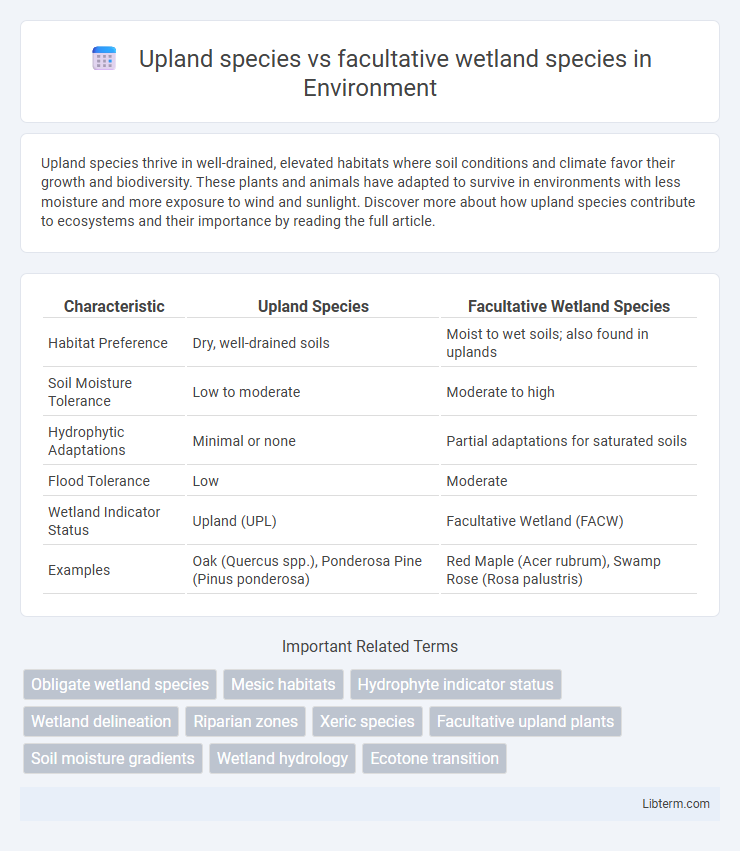Upland species thrive in well-drained, elevated habitats where soil conditions and climate favor their growth and biodiversity. These plants and animals have adapted to survive in environments with less moisture and more exposure to wind and sunlight. Discover more about how upland species contribute to ecosystems and their importance by reading the full article.
Table of Comparison
| Characteristic | Upland Species | Facultative Wetland Species |
|---|---|---|
| Habitat Preference | Dry, well-drained soils | Moist to wet soils; also found in uplands |
| Soil Moisture Tolerance | Low to moderate | Moderate to high |
| Hydrophytic Adaptations | Minimal or none | Partial adaptations for saturated soils |
| Flood Tolerance | Low | Moderate |
| Wetland Indicator Status | Upland (UPL) | Facultative Wetland (FACW) |
| Examples | Oak (Quercus spp.), Ponderosa Pine (Pinus ponderosa) | Red Maple (Acer rubrum), Swamp Rose (Rosa palustris) |
Introduction to Upland and Facultative Wetland Species
Upland species are plants adapted to dry, well-drained soils and rarely occur in wetlands, exhibiting traits for drought resistance and nutrient acquisition in terrestrial environments. Facultative wetland species thrive in both wetland and non-wetland areas, showing flexible adaptations that allow survival across variable moisture conditions. Understanding these plant categories is crucial for wetland delineation, ecosystem management, and biodiversity conservation due to their distinct hydrological tolerances and ecological roles.
Defining Upland Species
Upland species are plants that primarily thrive in dry, well-drained soils and rarely occur in wetlands, contrasting with facultative wetland species that can grow in both wetland and non-wetland areas. Upland species are typically found in terrestrial ecosystems where soil moisture is limited, and they have adaptations that enable survival in drier conditions. The U.S. Fish and Wildlife Service categorizes upland species as those with a less than 1% probability of occurring in wetlands under natural conditions.
Characteristics of Facultative Wetland Species
Facultative wetland species are plants that typically grow in wetlands but can also thrive in upland areas, distinguishing them by their adaptability to varying moisture conditions. These species exhibit morphological and physiological traits such as aerenchyma tissue for oxygen transport and tolerance to periodic flooding, allowing them to survive in both saturated and drier soils. Their presence is a critical indicator for wetland delineation, bridging the ecological gap between obligate wetland species and upland species.
Habitat Preferences and Distribution
Upland species thrive in well-drained soils and are predominantly found in terrestrial environments such as forests, grasslands, and deserts, where moisture availability is limited or seasonal. Facultative wetland species exhibit flexible habitat preferences, occurring in both wetland and non-wetland areas, often favoring moist soils but capable of surviving in drier upland sites. Distribution patterns of upland species are generally restricted away from saturated soils, while facultative wetland species occupy transitional zones, demonstrating adaptability to fluctuating hydrological conditions.
Adaptations to Environmental Conditions
Upland species exhibit deep root systems and waxy leaf coatings to conserve water and withstand drought conditions, thriving in well-drained, nutrient-poor soils. Facultative wetland species possess specialized aerenchyma tissue and lenticels to facilitate oxygen transport in saturated, low-oxygen environments and can survive both waterlogged and drier soils. These adaptive traits enable each species group to optimize survival and growth under distinct hydrological regimes.
Key Differences in Water Tolerance
Upland species thrive in well-drained soils and exhibit low water tolerance, typically avoiding saturated or flooded conditions. Facultative wetland species adapt to both saturated and drier soils, demonstrating moderate to high water tolerance and often occurring in transitional zones between uplands and wetlands. The key difference lies in their physiological adaptations, where facultative wetland species possess mechanisms to survive periodic flooding, unlike upland species.
Role in Ecosystem Functioning
Upland species primarily contribute to soil stabilization and nutrient cycling in terrestrial ecosystems, supporting biodiversity and preventing erosion. Facultative wetland species enhance water filtration, provide critical habitat for aquatic organisms, and facilitate nutrient retention in fluctuating hydrological conditions. Both groups play complementary roles in maintaining ecosystem resilience by regulating water flow, supporting food webs, and promoting habitat diversity.
Indicator Value for Wetland Delineation
Upland species have an Indicator Value for Wetland Delineation typically less than 1%, indicating their occurrence is almost exclusively in non-wetland areas, whereas facultative wetland species exhibit an Indicator Value ranging from 34% to 66%, reflecting their adaptability to both wetland and non-wetland conditions. This numerical categorization assists ecologists in accurately determining hydrophytic vegetation presence during wetland assessments. The precise classification of plant species based on these indicator values is crucial for effective wetland delineation and environmental regulatory compliance.
Conservation and Management Implications
Upland species, adapted to well-drained, dry habitats, require conservation strategies emphasizing soil stabilization and protection from habitat fragmentation. Facultative wetland species, thriving in both wet and dry conditions, demand flexible management approaches that maintain hydrological regimes and buffer zones to support ecosystem resilience. Effective conservation integrates species-specific habitat needs, enhancing biodiversity and ecosystem services in transitional landscapes.
Case Studies: Comparing Regional Species
Case studies comparing upland species and facultative wetland species reveal significant variations in habitat adaptability and ecological functions across regions. Upland species, such as Quercus alba and Pinus taeda, typically dominate well-drained soils, while facultative wetland species like Spartina patens and Juncus effusus thrive in both wet and dry conditions, demonstrating versatile hydrological tolerance. Regional comparisons highlight how factors like soil moisture gradients and climate influence species distribution, informing wetland restoration and conservation strategies.
Upland species Infographic

 libterm.com
libterm.com